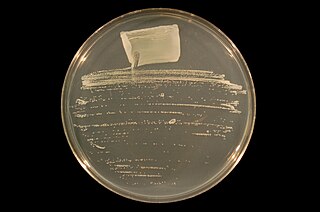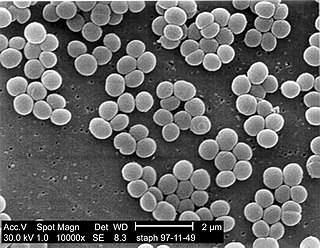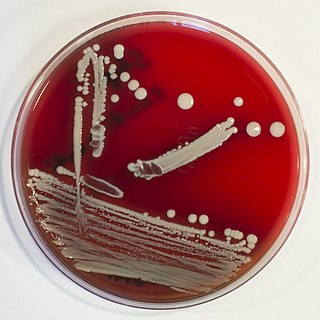
Thermus is a genus of thermophilic bacteria. It is one of several bacteria belonging to the Deinococcota phylum. Thermus species can be distinguished from other genera in the family Thermaceae as well as all other bacteria by the presence of eight conserved signature indels (CSIs) found in proteins such as adenylate kinase and replicative DNA helicase as well as 14 conserved signature proteins (CSPs) that are exclusively shared by members of this genus.
Alteromonas is a genus of Pseudomonadota found in sea water, either in the open ocean or in the coast. It is Gram-negative. Its cells are curved rods with a single polar flagellum.

Ensifer is a genus of nitrogen-fixing bacteria (rhizobia), three of which have been sequenced.

Staphylococcus is a genus of Gram-positive bacteria in the family Staphylococcaceae from the order Bacillales. Under the microscope, they appear spherical (cocci), and form in grape-like clusters. Staphylococcus species are facultative anaerobic organisms.
Thermoanaerobacter is a genus in the phylum Bacillota (Bacteria). Members of this genus are thermophilic and anaerobic, several of them were previously described as Clostridium species and members of the now obsolete genera Acetogenium and Thermobacteroides
Dactylosporangium is a genus of bacteria in the phylum Actinomycetota.

Staphylococcus condimenti is a Gram-positive, coagulase-negative member of the bacterial genus Staphylococcus consisting of single, paired, and clustered cocci. Strains of this species were originally isolated from fermenting soy sauce mash and are positive for catalase, urease, arginine dihydrolase, nitrate reductase, beta-galactosidase, and phosphatase activity.
Staphylococcus stepanovicii is a Gram-positive, coagulase-negative member of the bacterial genus Staphylococcus consisting of single, paired, and clustered cocci. The species is novobiocin-resistant and oxidase-positive. It was named in honor of Serbian microbiologist Srdjan Stepanović.
Staphylococcus auricularis is a Gram-positive member of the bacterial genus Staphylococcus consisting of pairs or tetrads of cocci. This species was originally isolated from the exterior of a human ear and is weakly hemolytic. Because it commonly exists on human skin, it may be able to cause opportunistic infections or sepsis, although this is very rare.
Staphylococcus lentus is a Gram-positive, oxidase-positive, coagulase-negative member of the bacterial genus Staphylococcus consisting of clustered cocci. The species was originally classified as a subspecies; its name is a combination derived from Staphylococcus sciuri subsp. lentus.
Mammaliicoccus sciuri, previously Staphylococcus sciuri, is a Gram-positive, oxidase-positive, coagulase-negative member of the bacterial genus Mammaliicoccus consisting of clustered cocci. The type subspecies M. sciuri subsp. sciuri was originally known as Staphylococcus sciuri subsp. sciuri and used to categorize 35 strains shown to use cellobiose, galactose, sucrose, and glycerol.
Staphylococcus gallinarum is a Gram-positive, coagulase-negative member of the bacterial genus Staphylococcus consisting of single, paired, and clustered cocci. Strains of this species were first isolated from chickens and a pheasant. The cells contain cell walls with chemical similarity to those of Staphylococcus epidermidis. Since its initial discovery, S. gallinarum has also been found in the saliva of healthy human adults.
Staphylococcus piscifermentans is a Gram-positive, coagulase-negative member of the bacterial genus Staphylococcus consisting of clustered cocci. This species was originally isolated from fermented fish in Thailand. A later study found a strain of S. piscifermentans in dog feces. The species is used in the preparation of fermented foods along with Staphylococcus carnosus; both species reduce nitrate and produce ammonia.
Staphylococcus lutrae is a species of Gram-positive bacteria and a member of the genus Staphylococcus. Strains of this species were originally isolated from otters and are coagulase-positive.
Streptomyces bungoensis is a bacterium species from the genus of Streptomyces which was isolated from soil from Japan. A P450 from Streptomyces bungoensis has been used to convert pladienolide B to pladienolide D.
Xanthobacter tagetidis is a bacterium from the family of Xanthobacteraceae which has been isolated from soil from Root balls around the plant Tagetes patula in the United Kingdom. Xanthobacter tagetidis has the ability to grow on substituted thiophenes.
Rhodobium orientis is a phototrophic, Gram-negative, rod-shaped and motile bacterium species from the genus of Rhodobium which has been isolated from coastal seawater from Makurazaki in Japan.
Streptomyces thermoalcalitolerans is a bacterium species from the genus of Streptomyces which has been isolated from garden soil in Yogyakarta on Indonesia.
Sphingomonas asaccharolytica is a bacterium from the genus of Sphingomonas which has been isolated from roots from an apple tree in Japan.
Sphingomonas pruni is a bacterium from the genus of Sphingomonas which has been isolated from the roots of the tree Prunus persica in Japan .



